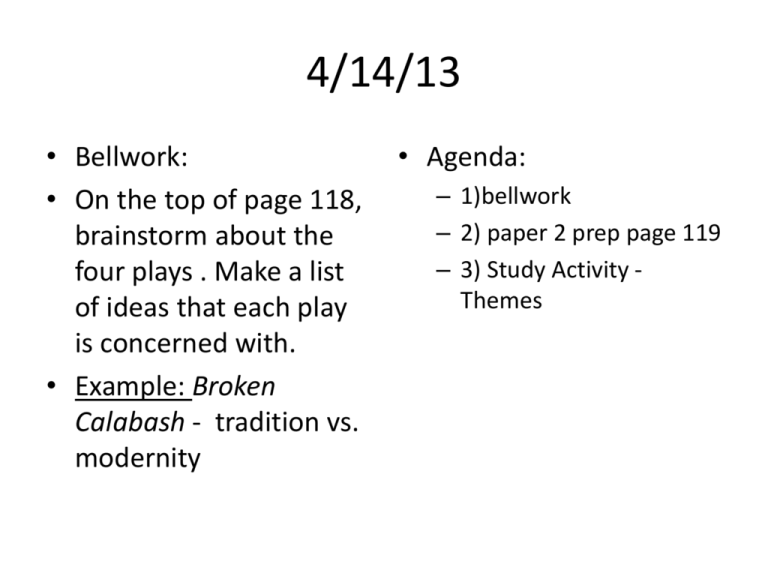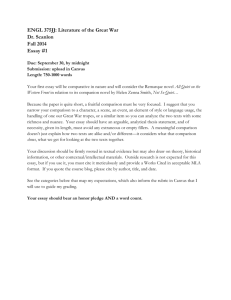Paper 2 prep
advertisement

4/14/13 • Bellwork: • On the top of page 118, brainstorm about the four plays . Make a list of ideas that each play is concerned with. • Example: Broken Calabash - tradition vs. modernity • Agenda: – 1)bellwork – 2) paper 2 prep page 119 – 3) Study Activity Themes Advice for the Paper 2 essay (Drama compare/contrast) • 1) Look carefully at the questions. – Attack the prompts by identifying all the key terms in a question. – Define any ambiguous words to make clear to examiner what YOU mean. – If a question asks you two things, like to consider a specific literary feature and its effect, then you must talk about BOTH. • EXAMPLE: ‘How have the authors of the texts that you have studied presented characters who are outsiders or alienated from society in the texts you have studied and what does this reveal about the authors main themes or concerns?’ In order to do well you will have to answer both the ‘How’ and ‘What’ parts of the question – If you can’t do that, pick another question. Advice for paper 2 • 2) Choose your texts wisely – Remember, the questions are general, so you need to apply the works you studied to them. You have to narrow your focus of these questions so that TWO of the FOUR texts are addressed. – Brainstorm for each question and for each text. How many examples from each text can you think of for each question? – Then, you can narrow down your choices and develop the essay. Advice for paper 2 • 3) Develop points/thesis – After brainstorming, you should have A LOT of material and examples. Decide on your thesis or point you will argue in your essay. • EXAMPLE: “Do actions speak louder than words? Discuss this statement with reference to the how actions or dialogue are used to convey themes in two of the texts that you have studied.’ • Your thesis might be You might answer “actions are more significant in conveying theme in ‘A Streetcar Named Desire’, but dialogue is of greater significance in The Crucible.” Advice for paper 2 • 4) Introduction: – A good introduction will make clear the thesis that you are going to argue and the order in which you will make them. This will help you structure your essay clearly by letting the examiner know what to expect. – A brief ‘taste’ of your two or three main points will be enough because you will go on to develop those points in detail in the rest of your essay. Advice for paper 2 • 5) The ESSAY! – Prove your thesis by giving an example of each assertion or point you make. (REMEMBER P.E.A.) – Be sure to address the question and show detailed knowledge of the text and comment on as many literary features as possible to assist in answering the question. – Do not make gross generalizations. Be specific. – No two writers are the same and no two plays are the same. Even if both plays allows you to respond to a question in a similar manner, do point out the differences and the distinction. – Always write from the viewpoint of how the writer has constructed the work in order to achieve a given effect. – Keep key words in mind: Action, Dialogue, Theme. Try to keep those at the front and center of the discussion so the examiner doesn’t wonder what you are writing about. Advice for paper 2 • 6) Conclusion – Restate your thesis and points clearly and in a more relaxed way, showing you are ‘resting’ your argument. – The conclusion should pull the entire essay together. – PROOFREAD. Aspects of texts that are frequently asked about include: • How dramatists present characters and communicate to the audience their thoughts and motivations • How dramatists present their ideas and thematic concerns to the audience • The structure of the plays and the effect this has on the audience • The use of a particular dramatic feature – motif, dialogue, setting, etc - in the texts and the effect that this has on the audience • The importance of conflict in drama • The beginnings and endings of the plays … or other key moments of your choice





